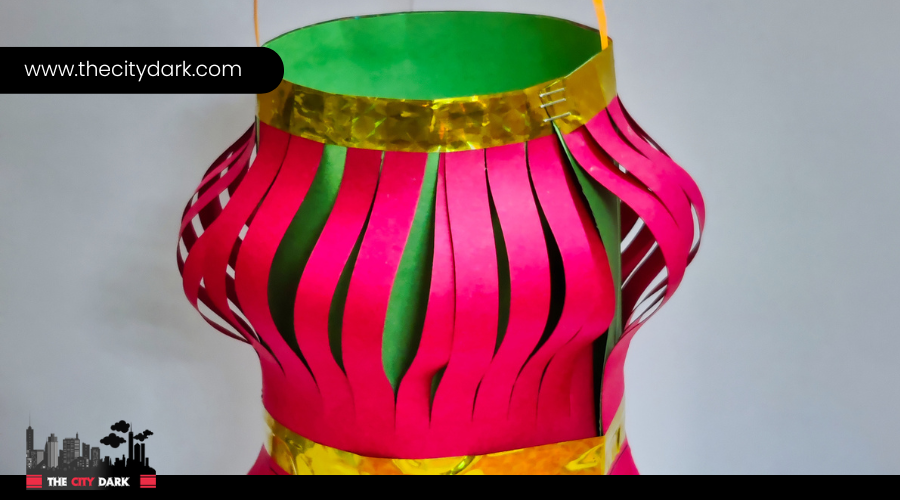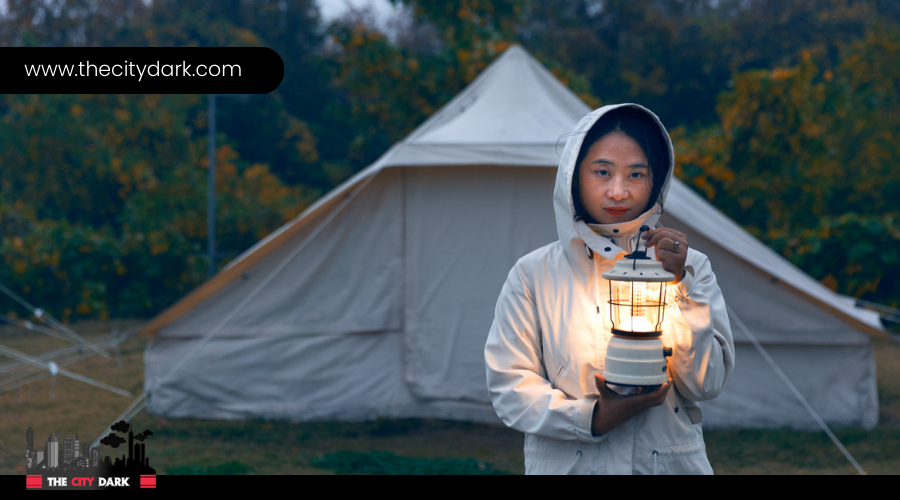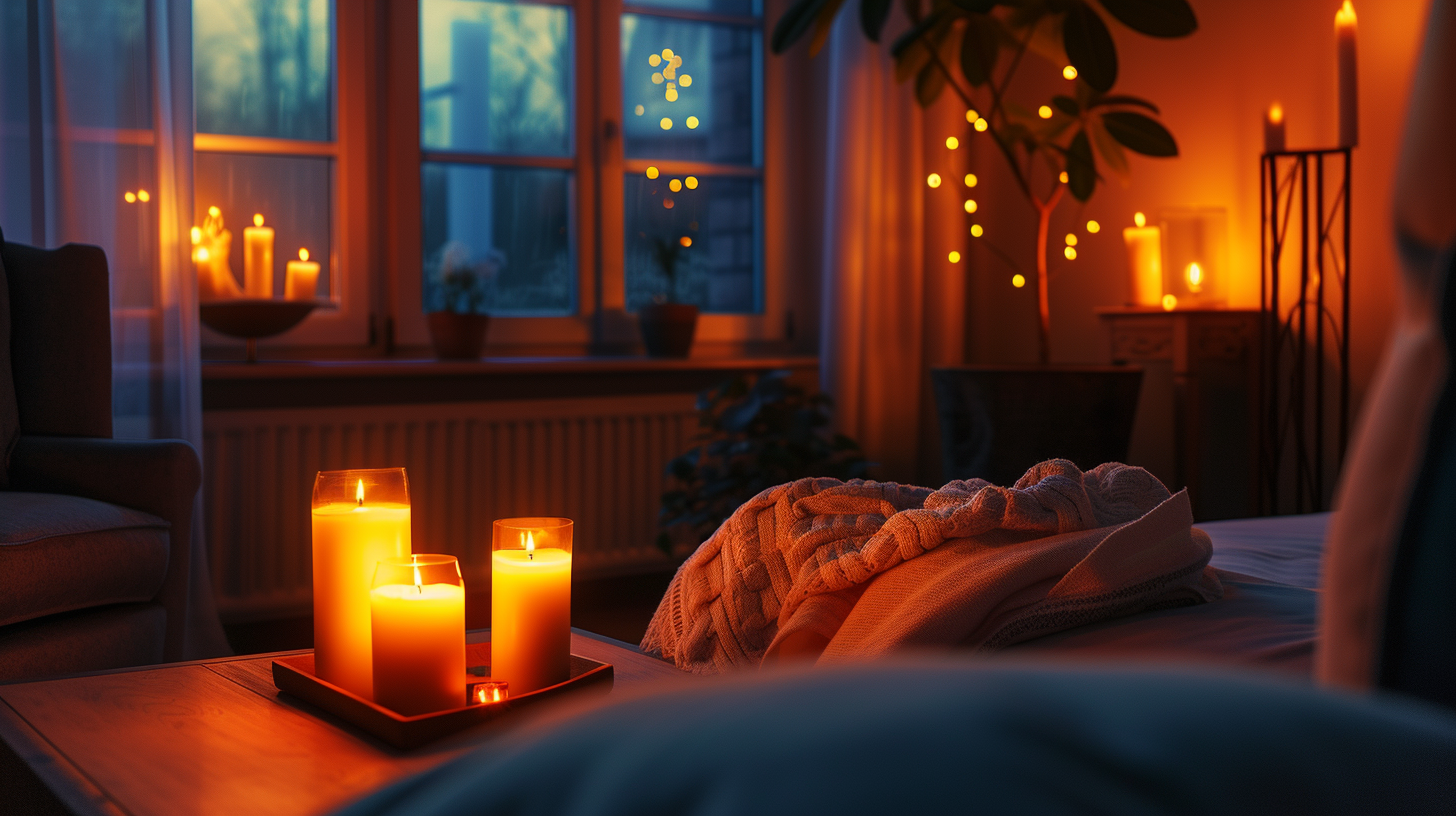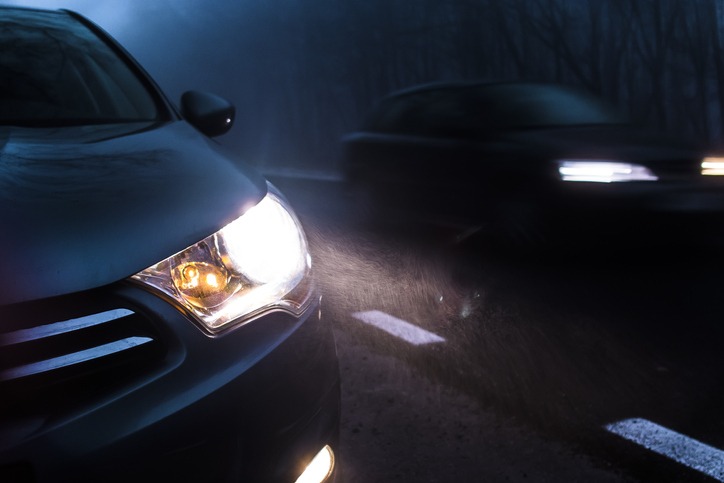How to Create a Power Outage Lighting Plan for Your Home

Creating a power outage lighting plan for your home involves several key steps to ensure safety and preparedness. Start by identifying crucial areas that require illumination, such as staircases and hallways, to prevent accidents.
Consider the number of people in your household and the typical duration of outages to determine the appropriate amount and types of light sources. Stock up on essential items like LED flashlights, solar-powered lights, and batteries, ensuring they are easily accessible.
Educate your family on the safe use of these lights and emphasize fire safety, especially if candles are part of your plan. Organize and maintain your supplies by storing them in a designated, easily reachable location, and regularly check that all items are in working order. This approach will help ensure your home is well-prepared for any power outage.
Understand Power Outage Causes

Understanding the common causes of power outages can help you better prepare for them. Severe weather is a primary cause, as lightning strikes, high winds, and heavy rain can damage power lines, leading to both short-term interruptions and extended periods without power. Having an emergency plan in place for such events is essential.
Equipment failures also significantly contribute to power outages. Issues with cables, transformers, and other infrastructure components can suddenly disrupt power supply. While regular maintenance by utility companies mitigates some risks, unforeseen breakdowns can still occur.
Human errors are another factor. Accidents during construction or mishaps involving power infrastructure can cause unexpected outages. For example, construction crews might accidentally cut through a power line, resulting in an immediate power loss.
Animals, surprisingly, are frequent culprits behind power interruptions. Birds, squirrels, and other critters can damage power lines or transformers, causing outages. Their interactions with electrical equipment often result in temporary interruptions, but can sometimes lead to more significant problems.
Understanding these causes helps in developing better preparedness strategies, ensuring you can effectively manage and respond to power outages.
Assess Your Lighting Needs
Once you understand the causes of power outages, it's crucial to assess your home's lighting needs to ensure safety and convenience. Begin by identifying areas that need illumination, such as hallways, bathrooms, and living spaces. Consider the tasks you'll perform, like reading, cooking, or navigating stairs. Task lighting is essential; consider using LED bulbs and keep an LED flashlight accessible.
Evaluate the number of occupants to ensure everyone has adequate lighting. For instance, placing an LED camping lantern or solar lanterns in central locations can provide light for everyone. Include a reliable light source in your emergency kit for quick access during unexpected outages.
Consider the typical duration of power outages in your area. For short-term outages, battery-operated LED flashlights might be sufficient. For longer outages, more sustainable options like solar lights or portable generators may be necessary. Additionally, account for special needs, such as medical equipment that requires electricity, and plan accordingly.
Choose Portable Light Sources
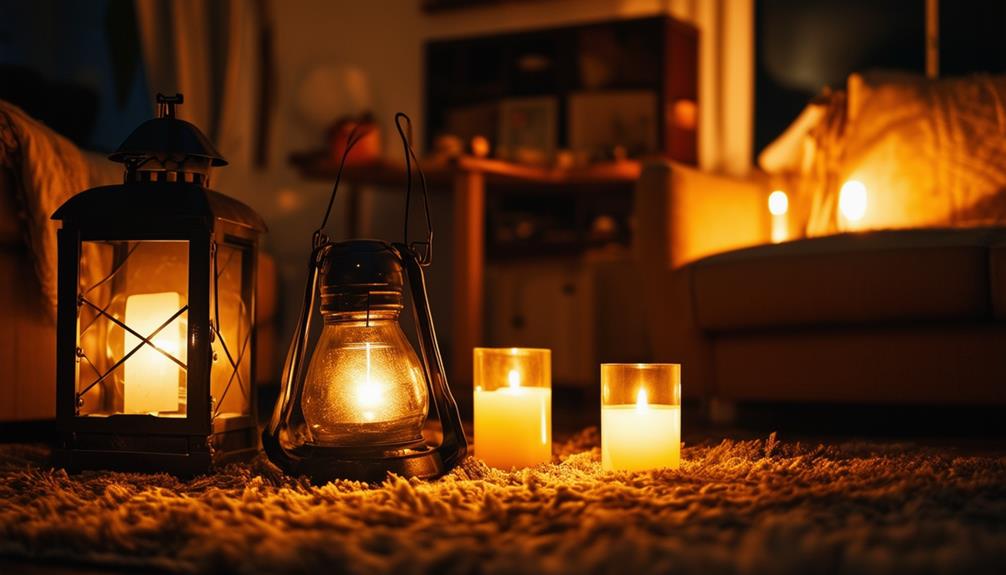
Choosing the right portable light sources ensures dependable illumination during power outages. To enhance your preparedness, include a variety of light sources in your emergency kit.
Here are four essential options to consider:
- LED Flashlights: These provide focused lighting, ideal for navigating dark areas. They're energy-efficient and can last several hours on a single charge.
- Battery-Operated Lanterns: Offering 360-degree illumination, these are perfect for lighting entire rooms. Ensure you have spare batteries to extend their usability during prolonged outages.
- Solar-Powered Lights: Charge these in advance for sustainable lighting. They can provide several hours of light without relying on batteries, even during extended power outages.
- Hand-Cranked Lights: Essential for emergencies, these lights don't depend on batteries or electrical charge. A few minutes of cranking can generate enough power to keep the lights on for hours.
Additionally, glow sticks offer quick, low-illumination light. By integrating these portable light sources, you can ensure your home remains well-lit and your power outage experience is manageable, regardless of the outage duration.
Opt for Battery-Powered Lights
Opting for battery-operated lights ensures a reliable and portable lighting solution during power outages. These lights offer unmatched mobility and flexibility, making them essential for any emergency plan. With battery-operated lights, you can easily navigate your home or take them outside if needed.
Consider using rechargeable batteries for long-term use, as they're cost-effective and eco-friendly. LED lights are an excellent choice for battery-operated options due to their energy efficiency and longevity. They provide bright illumination while conserving power, allowing your lights to last longer during extended outages.
Having a variety of lights, such as lanterns, flashlights, and headlamps, prepares you for different lighting needs. Lanterns can illuminate a room, while flashlights and headlamps offer focused beams for tasks requiring precision.
Don't forget to stock up on extra batteries to ensure continuous operation of your lights. Keeping a good supply on hand means you won't be left in the dark when the power goes out.
Utilize Solar-Powered Options
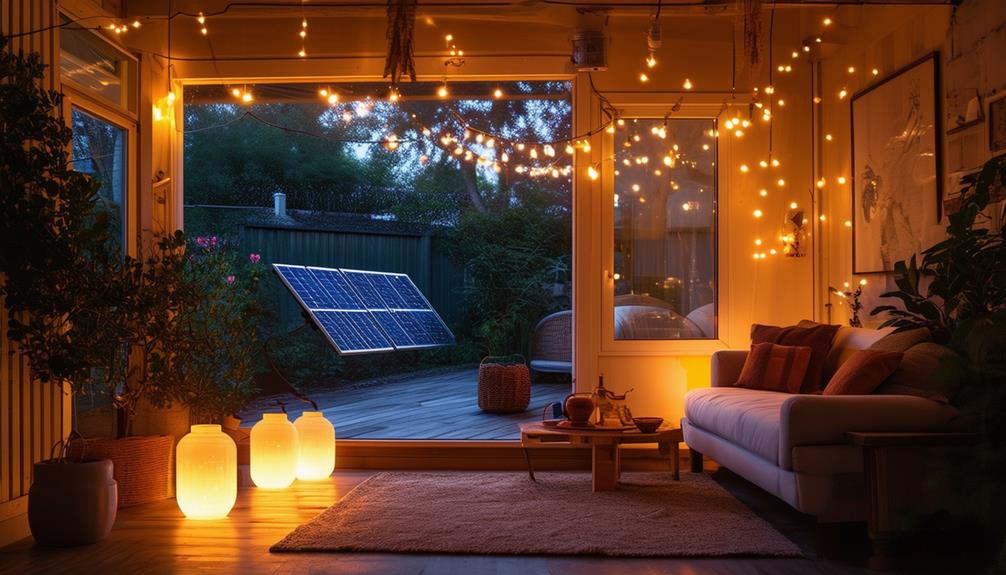
Consider using solar-powered options for an eco-friendly and sustainable lighting solution during power outages. By selecting the appropriate solar devices and installing them in south-facing windows, you can ensure they charge efficiently. Solar landscape, path, and security lights provide safety and visibility without relying on electricity.
Solar Lighting Benefits
Solar lighting offers numerous advantages, making it an excellent choice for reliable illumination during power outages. By utilizing sunlight as a renewable energy source, solar lighting is both eco-friendly and sustainable.
Here are some compelling reasons to consider solar-powered options:
- Cost-efficient: Solar lights require minimal maintenance and have low operating costs, saving you money in the long run.
- Independent of the power grid: Solar lights provide reliable illumination without relying on the electrical grid, ensuring light during power outages.
- Easy installation: Solar lights are simple to set up and can be strategically placed around your home for optimal lighting.
- Environmentally friendly: Using solar lighting reduces your carbon footprint and energy consumption, contributing to a more sustainable environment.
Incorporating solar lighting into your home's power outage plan offers a range of benefits. These lights are cost-effective, easy to install, and ensure your home remains illuminated independently of the power grid. Moreover, by choosing solar lighting, you're opting for a greener solution that minimizes your carbon footprint and supports a sustainable lifestyle.
Choosing Solar Devices
When selecting solar devices for your home, prioritize those that efficiently convert sunlight into electrical energy and store it for consistent use during power outages. Solar devices provide a sustainable lighting solution that doesn't rely on traditional power sources, ensuring you have reliable illumination even when the grid is down.
To ensure continuous lighting, opt for solar products with robust battery storage. This feature allows the devices to gather and store energy during the day, ensuring you have light when you need it most.
For optimal performance, place your solar devices in south-facing windows to maximize exposure to sunlight, which enhances efficient charging and readiness for use.
Safety is another critical factor. Unlike candles or lanterns that use open flames, solar devices eliminate fire hazards, making them a safer choice for your home. This allows you to avoid the risks associated with open flames while maintaining a well-lit environment.
Installing Solar Lights
To effectively set up solar lights, start by choosing appropriate locations that receive ample sunlight throughout the day. This ensures the batteries are fully charged to provide reliable illumination during power outages. Solar lights are eco-friendly and sustainable, offering a convenient installation process without the need for electrical wiring.
Here's a quick guide to get you started:
- Identify Key Areas: Choose outdoor spaces like gardens, walkways, and patios where improved visibility is essential.
- Select the Right Types: Pick from different designs, such as pathway lights, security lights, and lanterns, to meet your specific lighting needs.
- Position for Optimal Sunlight: Ensure your solar lights are placed in areas that receive direct sunlight for most of the day to optimize battery charging.
- Test and Adjust: After installation, check the illumination at night and adjust the positioning if necessary to maximize light coverage.
Explore Alternative Light Sources
Have you considered how alternative light sources can brighten your home during a power outage? Exploring different options can make a significant difference in maintaining visibility and safety.
LED Camping Lanterns
LED camping lanterns are excellent for power outages, offering portable illumination with a 360-degree reach. They're efficient and easy to move around, making them a versatile choice for emergency lighting.
Glow Sticks
Glow sticks provide instant light and are a disposable option for emergency lighting. While not as bright, they're great for quick, temporary use and can be especially fun for kids.
Kerosene Lanterns
Kerosene lanterns emit a soft glow and bring a nostalgic feel. However, they require caution and a steady supply of fuel.
Solar Lighting
Solar lighting is an eco-friendly and sustainable choice. Just remember to charge them in advance.
Battery-Operated Lights
Battery-operated lights are another practical solution, providing task lighting and portable illumination when the power is out.
Here's a quick comparison:
| Light Source | Features |
|---|---|
| LED Camping Lanterns | Portable, 360-degree illumination |
| Glow Sticks | Instant light, lower illumination |
| Kerosene Lanterns | Soft glow, requires fuel |
| Solar Lighting | Eco-friendly, needs pre-charging |
| Battery-Operated Lights | Task lighting, portable |
Create a Lighting Supply Area
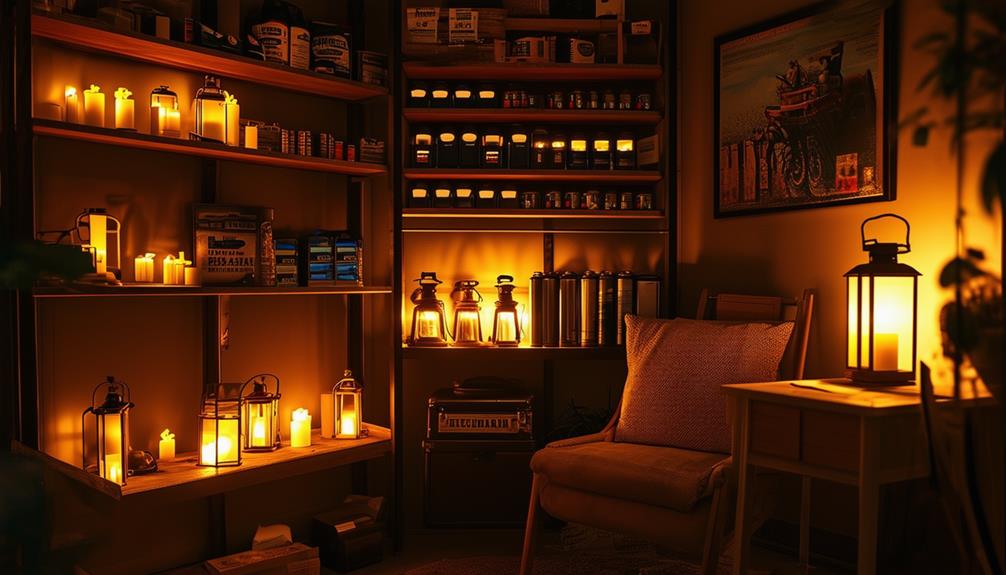
After exploring various alternative light sources, the next step is to create a dedicated lighting supply area in your home. This central area ensures easy access to necessary lighting supplies during power outages.
Here's how to set up your lighting supply area effectively:
- Choose a Central Location: Designate a specific cabinet or shelf that's easily accessible to everyone in your household. This ensures no one will have to fumble around in the dark searching for lighting supplies.
- Stock Essential Lighting Items: Ensure your lighting supply area is well-stocked with flashlights, candles, and extra batteries. Include a variety of alternative light sources like solar-powered lights, hand-cranked flashlights, and battery-operated lanterns.
- Organize for Quick Access: Arrange your supplies neatly so you can quickly grab what you need. Consider labeling sections for different items to make finding things even easier.
- Maintain Regularly: Regularly check your supplies to replace expired batteries and confirm all devices are in working condition. Keeping your lighting supply area updated guarantees you're always prepared for unexpected power outages.
Educate Your Family
Ensure everyone in your household understands the power outage lighting plan to guarantee safety and readiness. Family education is critical for ensuring everyone knows how to use emergency lighting sources like flashlights, lanterns, and candles efficiently and safely. Discuss where your lighting supplies are stored so they're easily reachable during an outage. Emphasize the importance of fire safety, especially when using candles, to minimize fire risks.
Create a simple, easy-to-follow emergency lighting plan and involve everyone in the practice and preparation. Here's a helpful table to guide your discussions and ensure thorough family education:
| Topic | Key Points | Action Required |
|---|---|---|
| Lighting Supplies | Flashlights, lanterns, candles | Store in a central, accessible location |
| Fire Safety | Risks of using candles | Teach appropriate candle safety measures |
| Emergency Lighting Plan | Steps to activate lighting during an outage | Practice regularly with the family |
| Safety Measures | Prevent trips and falls | Clear pathways and keep lights accessible |
Conclusion
With a well-prepared power outage lighting plan, you can confidently face any blackout. Keep your portable lights accessible, maintain your supply area, and ensure every family member knows the procedures.
If you use candles, practice fire safety diligently. Staying organized and prepared will keep your home safe and illuminated during outages. Don't wait for the lights to go out—start planning today to ensure you're always ready for the unexpected!

